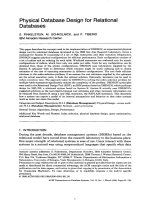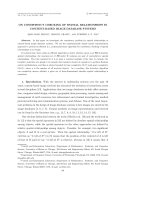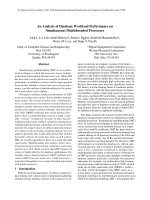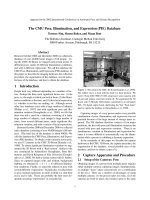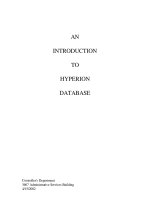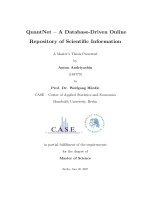Physical exercise database potx
Bạn đang xem bản rút gọn của tài liệu. Xem và tải ngay bản đầy đủ của tài liệu tại đây (3.15 MB, 239 trang )
Physical exercise database
Petri Tuononen
Turku University of Applied Sciences
Information Technology
Relational Databases
18.09.2009
Table of Contents
1. Prerequisites 1
1.1 The database environment 1
1.2 Used software 1
1.3 Security - Things to take into account 1
2. Installing LAMP and initial configuration 2
2.1 Apache web server configuration 2
2.1.1 To check that Apache is working 2
2.1.2 To change website location on the server 2
2.2 MySQL database server configuration 3
2.3 PhpMyAdmin configuration 4
2.3.1 Configure phpmyadmin with 'linked-tables infrastructure features 4
2.3.2 Create tables for 'Linked-tables infrastructure' 5
2.3.3 Access PHPMyAdmin 5
2.4 PHP configuration 5
3. SportLog database 6
3.1 Miniworld 6
3.2 Project syntax style design 6
3.3 Entity-relationship diagram 7
3.4 Relational model 8
3.5 User rights 9
3.6 Authentication 9
3.7 Data maintenance 9
3.8 Indexes 11
3.9 MySQL Storage Engine 11
3.10 User interface 11
3.10.1 Technical implementation 11
3.10.2 Navigation 12
3.10.3 Screenshots 13
3.10.3.1 Login 13
3.10.3.2 Register 14
3.10.3.3 Index 15
3.10.3.4 Navigation 16
3.10.3.5 Select menu 19
3.10.3.6 Show menu (Select->All option) 19
3.10.3.7 Show menu (Select->Athlete option) 25
3.10.3.8 Add menu 29
3.10.3.9 Account menu 35
3.10.3.10 Info menu 38
3.10.3.11 Admin area 39
3.10.3.12 Edit 42
3.11 Database code 50
3.12 Adding sample data 53
3.13 Creating registration database 55
3.14 Creating MySQL users to allow connection to SportLog related databases 56
4. Backup 56
4.1 Mysqldump method 56
4.1.1 Backup with mysqldump 56
4.1.2 Restoring with mysqldump 56
4.2 phpMyAdmin method 56
4.2.1 Backup with phpMyAdmin 56
4.2.2 Restoring with phpMyAdmin 57
4.3 Task scheduling 57
4.4 Email backup with encryption 57
4.4.1 Instructions 57
4.5 FTP backup with scheduling and web user interface 58
5. References 59
6. Appendix A 60
6.1 Triggers 60
6.1.1 Increase equipment's total use 60
6.1.1.1 Purpose of the trigger 60
7. Appendix B 61
7.1 Stored procedures 61
7.1.1 List of stored procedures 61
7.1.2 Source code 63
7.1.2.1 Registration database stored procedures 63
7.1.2.2 Sportlog database stored procedures 64
7.1.2.3 Registration database grants 73
7.1.2.4 Sportlog database grants 73
8. Appendix C 77
8.1 Web site file listing 77
8.2 Web site source code 79
8.2.1 /var/www/sportlog/ 79
8.2.1.1 add_athlete.php 79
8.2.1.2 add_coach.php 84
8.2.1.3 add_equipment.php 87
8.2.1.4 add_exercise_dropdown.js 90
8.2.1.5 add_exercise.php 91
8.2.1.6 add_match.php 101
8.2.1.7 add_owned_equipment.php 111
8.2.1.8 add_personal_coach.php 116
8.2.1.9 add_sport.php 119
8.2.1.10 add_team.php 121
8.2.1.11 auth_user.inc.php 123
8.2.1.12 backup.php 123
8.2.1.13 conn_auth.inc.php 124
8.2.1.14 conn_login_attempt.inc.php 124
8.2.1.15 conn_reg.inc.php 124
8.2.1.16 conn_sportlog.inc.php 124
8.2.1.17 delete_account.php 124
8.2.1.18 delete_athlete.php 125
8.2.1.19 delete_coach.php 125
8.2.1.20 delete_equipment.php 126
8.2.1.21 delete_exercise.php 126
8.2.1.22 delete_match.php 126
8.2.1.23 delete_owned_equipment.php 127
8.2.1.24 delete_personal_coach.php 127
8.2.1.25 delete_sport.php 127
8.2.1.26 delete_team.php 129
8.2.1.27 edit_athlete.php 129
8.2.1.28 edit_coach.php 135
8.2.1.29 edit_equipment.php 138
8.2.1.30 edit_exercise.php 142
8.2.1.31 edit_match.php 155
8.2.1.32 edit_owned_equipment.php 166
8.2.1.33 edit_personal_coach.php 171
8.2.1.34 edit_sport.php 174
8.2.1.35 edit_team.php 176
8.2.1.36 footer_login.php 178
8.2.1.37 footer.php 179
8.2.1.38 get_models.js 179
8.2.1.39 get_models.php 179
8.2.1.40 header_menu.php 180
8.2.1.41 header.php 180
8.2.1.42 header_show.php 180
8.2.1.43 index.php 181
8.2.1.44 info.php 181
8.2.1.45 logged_user.php 182
8.2.1.46 logout.php 182
8.2.1.47 menu.php 182
8.2.1.48 middle_login.php 183
8.2.1.49 middle.php 183
8.2.1.50 middle_register.php 184
8.2.1.51 person_brand_model_dropdown.php 184
8.2.1.52 register.php 185
8.2.1.53 reset_form.js 188
8.2.1.54 select_all_menu_option.php 188
8.2.1.55 select_athlete.php 188
8.2.1.56 show_all_athletes.php 189
8.2.1.57 show_all_exercises.php 190
8.2.1.58 show_all_owned_equipment.php 191
8.2.1.59 show_all_personal_coaches.php 193
8.2.1.60 show_athlete.php 194
8.2.1.61 show_coaches.php 195
8.2.1.62 show_coach.php 196
8.2.1.63 show_equipment.php 197
8.2.1.64 show_exercises.php 198
8.2.1.65 show_matches.php 200
8.2.1.66 show_owned_equipment.php 201
8.2.1.67 show_personal_coaches.php 202
8.2.1.68 show_selected_athlete.php 203
8.2.1.69 show_sport.php 204
8.2.1.70 show_sports.php 205
8.2.1.71 show_summary_all.php 206
8.2.1.72 show_summary.php 207
8.2.1.73 show_team.php 208
8.2.1.74 show_teams.php 209
8.2.1.75 update_account.php 210
8.2.1.76 user_login.php 211
8.2.1.77 user_personal.php 214
8.2.2 /var/www/sportlog/admin 215
8.2.2.1 admin_area.php 215
8.2.2.2 admin_login.php 215
8.2.2.3 auth_admin.inc.php 217
8.2.2.4 conn.inc.php 217
8.2.2.5 delete_user.php 217
8.2.2.6 footer_admin.php 218
8.2.2.7 header_admin.php 218
8.2.2.8 index.php 219
8.2.2.9 logged_admin.php 219
8.2.2.10 logout.php 219
8.2.2.11 middle_admin.php 219
8.2.2.12 update_user.php 220
8.2.3 /var/www/sportlog/css 221
8.2.3.1 menu.css 221
8.2.3.2 sportlog.css 222
8.2.3.3 sportlog_print.css 224
8.2.3.4 sportlog_wider.css 226
8.2.3.5 sportlog_wider_print.css 228
8.2.4 /var/www/sportlog/php_functions 230
8.2.4.1 EmailAddressValidator.php 230
8.2.4.2 redirect.php 232
8.2.4.3 stored_procedure_tools.php 233
Physical exercise database Petri Tuononen
1. Prerequisites
1.1 The database environment
The database is installed on my personal server. The server is Linux based Kubuntu
distribution running LAMP, which comes from the words Linux, Apache, MySQL and PHP.
Server's network connection comes from my ADSL box which is NAT and firewall enabled.
The access rights are tightly controlled. My network is MAC filtered in such a way that only
defined devices can connect to my network. SSL connection is used when transferring
passwords. SSL keeps sure that all confidential information is transferred encrypted. PHP is
used in user interface to make dynamic websites and to access MySQL database. Website
is hosted on my server using Apache. Everything on the server side is done with open
source software. I used MySQLi database extension, but PDO would have been excellent as
well if not better.
1.2 Used software
At first I used Bluefish () as a coding editor when I wrote PHP,
XHTML, CSS and Javascript. It is a very practical program as it's lightweight and simple to
use. However it was lacking proper syntax error highlighting and some other powerful
features of Eclipse, so I ended up installing PHP integration for Eclipse. Kivio was used to
draw ER-model and OpenOffice Writer to write this document.
1.3 Security - Things to take into account
Security is one of the main aspect's of the whole database design. Database is configured to
be hacker proof. Linux as operating system is one of the most secure OS's available. Linux
always asks administrator password for system-wide operations. Firewall is configured to be
so restrictive that only specified IP-addresses with specified MAC-adresses can connect to
specified port. All unused ports are closed. I also use uncommon ports for different protocols.
MySQL root user access to phpmyadmin is denied.
The site has user authentication and the password is encrypted with MD5 (Message-Digest
algorithm 5) which can't be decrypted (without brute force or decrypted MD5 hash library
database), because it's a one-way hash algorithm. This ensures that the password is saved
in encrypted format to the database and even the admin is unable to see the password. The
whole site is SSL (Secure Socket Layer) secured. SSL is a series of cryptographic protocols
that provide security for communications over networks. SSL makes eavesdropping
impossible so nobody is able to catch user authentication traffic. It is reported widely that
many SQL based databases are prone to so called SQL injection. All user input is always
filtered before executing any SQL queries. This ensures that nobody is able to use any SQL
specific characters like ; " ' and alike to make their own hazardous remove all tables query.
Access to the database is very limited in such a way that executing only stored procedures is
permitted.
1
Physical exercise database Petri Tuononen
2. Installing LAMP and initial configuration
LAMP consists of Linux, Apache, MySQL and PHP. In addition phpMyAdmin is also installed
for easy web based mysql management.
On my home computer I use Kubuntu 9.04 Linux distribution. It doesn't matter which
distribution to use, but I base these instructions especially for Kubuntu.
Software packages to install:
sudo apt-get install mysql-server mysql-client apache2 php5 php5-mysql phpmyadmin
2.1 Apache web server configuration
2.1.1 To check that Apache is working
http://server_ip
If you can see Apache welcome message in your web browser then Apache is working.
To make this error message disappear when starting Apache.
apache2: Could not determine the server's fully qualified domain name, using 127.0.0.1 for
ServerName.
The following code creates a file with a line “ServerName localhost”.
echo "ServerName localhost" | sudo tee /etc/apache2/conf.d/fqdn
2.1.2 To change website location on the server
Create a folder for the new website.
sudo mkdir /var/www/sportlog
Restrict user rights.
sudo chmod 755 -R /var/www/sportlog
Create index.html to a new folder.
sudo touch /var/www/sportlog/index.html
Backup default apache configuration.
sudo cp /etc/apache2/sites-available/default /etc/apache2/sites-
available/default_bak
Make a symlink (should be already made by default).
sudo ln -s /etc/apache2/sites-available/default /etc/apache2/sites-
enabled/default
Edit default configuration file.
sudo nano /etc/apache2/sites-available/default
'DocumentRoot' is changed to point /var/www/
'Directory' is changed to /var/www/
Restart Apache for modifications to take effect.
sudo /etc/init.d/apache2 restart
2
Physical exercise database Petri Tuononen
Test web server.
In web browser type: localhost/sportlog
In case site should be show up with just typing the server.ip (or localhost) then change
'DocumentRoot' to point /var/www/sportlog in /etc/apache2/sites- available/default.
2.2 MySQL database server configuration
To modify MySQL server configuration file to allow access to the database from other
computers from the same network.
nano /etc/mysql/my.cnf
bind-address is changed from localhost to internal ip-address
To create MySQL root user password if not already set in installation.
mysql -u root
mysql> SET PASSWORD FOR 'root'@'localhost' = PASSWORD('yourpassword');
To connect to MySQL server.
mysql -h host -u user -p
To create a MySQL database.
mysql>create database databasename;
To create a new master user with high privileges to use sportlog database.
(localhost can be replaced with ip-addresses).
mysql> GRANT SELECT, INSERT, UPDATE, DELETE, CREATE, DROP, INDEX,
ALTER, CREATE TEMPORARY TABLES, LOCK TABLES ON sportlog.* TO
'yourusername'@'localhost' IDENTIFIED BY 'yourpassword';
To create a new typical user with lower rights to sportlog database.
mysql> GRANT SELECT, INSERT, UPDATE, DELETE
ON sportlog.* TO 'yourusername'@'localhost' IDENTIFIED BY 'yourpassword';
To create a control user for phpmyadmin (needed for 'linked-tables infrastructure' features).
mysql> GRANT USAGE ON mysql.* TO 'phpmyadmin'@'localhost' IDENTIFIED BY
'password';
mysql> GRANT SELECT (Host, User, Select_priv, Insert_priv, Update_priv,
Delete_priv, Create_priv, Drop_priv, Reload_priv, Shutdown_priv, Process_priv,
File_priv, Grant_priv, References_priv, Index_priv, Alter_priv, Show_db_priv,
Super_priv, Create_tmp_table_priv, Lock_tables_priv, Execute_priv,
Repl_slave_priv, Repl_client_priv) ON mysql.user TO
'phpmyadmin'@'localhost';
mysql> GRANT SELECT ON mysql.db TO 'phpmyadmin'@'localhost';
mysql> GRANT SELECT ON mysql.host TO 'phpmyadmin'@'localhost';
mysql> GRANT SELECT (Host, Db, User, Table_name, Table_priv,
Column_priv) ON mysql.tables_priv TO 'phpmyadmin'@'localhost';
mysql> FLUSH PRIVILEGES;
3
Physical exercise database Petri Tuononen
2.3 PhpMyAdmin configuration
2.3.1 Configure phpmyadmin with 'linked-tables infrastructure features
Make a backup.
sudo cp /usr/share/phpmyadmin/config.inc.php
/usr/share/phpmyadmin/config.inc.php_backup
Edit the file below.
sudo nano /usr/share/phpmyadmin/config.inc.php
The most important changes we make here are MySQLi extension, controluser, disabling
root access, port, socket, connect type, hosts, authentication, blowfish secret and defining
'linked-tables infrastructure' tables. I have deleted my blowfish_secret and password from
these instructions so you must remember to change your own passwords.
$cfg['blowfish_secret'] can be anything, but make it random.
<?php
/**
* Phpmyadmin configuration for many hosts.
*/
$i=0;
$hosts = array (
"localhost"
);
$cfg['blowfish_secret'] = ''; //write random characters
foreach ($hosts as $host) {
$i++;
$cfg['Servers'][$i]['host'] = $host;
$cfg['Servers'][$i]['port'] = '3306';
$cfg['Servers'][$i]['socket'] = '/var/run/mysqld/mysqld.sock';
$cfg['Servers'][$i]['connect_type'] = 'socket';
$cfg['Servers'][$i]['extension'] = 'mysqli';
$cfg['Servers'][$i]['compress'] = FALSE;
$cfg['Servers'][$i]['controluser'] = 'phpmyadmin';
$cfg['Servers'][$i]['controlpass'] = ''; //write password
$cfg['Servers'][$i]['auth_type'] = 'cookie';
// $cfg['Servers'][$i]['user'] = '';
// $cfg['Servers'][$i]['password'] = '';
$cfg['Servers'][$i]['AllowRoot'] = FALSE; //disables phpmyadmin root login
$cfg['ForceSSL'] = TRUE;
$cfg['Servers'][$i]['only_db'] = '';
$cfg['Servers'][$i]['verbose'] = '';
$cfg['Servers'][$i]['pmadb'] = 'phpmyadmin';
$cfg['Servers'][$i]['bookmarktable'] = 'pma_bookmark';
$cfg['Servers'][$i]['relation'] = 'pma_relation';
$cfg['Servers'][$i]['table_info'] = 'pma_table_info';
$cfg['Servers'][$i]['table_coords'] = 'pma_table_coords';
$cfg['Servers'][$i]['pdf_pages'] = 'pma_pdf_pages';
$cfg['Servers'][$i]['column_info'] = 'pma_column_info';
$cfg['Servers'][$i]['history'] = 'pma_history';
$cfg['Servers'][$i]['designer_coords'] = 'pma_designer_coords';
}
?>
4
Physical exercise database Petri Tuononen
Security aspects conserning the code above.
$cfg['Servers'][$i]['AllowRoot'] = FALSE; is optional but improves security, because it
disables phpmyadmin's root login.
2.3.2 Create tables for 'Linked-tables infrastructure'
Unpack create tables script.
sudo gzip -d /usr/share/doc/phpmyadmin/examples/create_tables_mysql_4_1_2+.s
ql.gz
Modify create tables script's privileges section.
Privileges
GRANT SELECT, INSERT, DELETE, UPDATE ON `phpmyadmin`.* TO
'pma'@localhost;
Change 'pma' on above code to 'phpmyadmin' or whatever your control user name is.
Execute create tables script.
mysql <
/usr/share/doc/phpmyadmin/examples/create_tables_mysql_4_1_2+.sql
-u root -p
2.3.3 Access PHPMyAdmin
http://localhost/phpmyadmin
or
/> 2.4 PHP configuration
Test that php is working.
nano /home/username/testphp.php
write <?php phpinfo(); ?> into the file and save
http://server_ip_address/testphp.php
5
Physical exercise database Petri Tuononen
3. SportLog database
3.1 Miniworld
Spotlog acts as a conventional way to log physical exercises by individuals or groups such
as football teams. It contains the most necessary things to log. Afterwards it's a great source
of information for coaches and keep-fit enthusiastics. Sportlog is a website where users can
register to get their own account and then add, edit, remove and show all their sport related
data. It's a practical way, because the service works on every machine capable of browsing
web pages and it works everywhere where you can access Internet. All data user has
submitted are always there. There's no need to upload data to user's computer, because all
transactions are done in the server.
User can add athlete, exercise, equipment, owned equipment, sport, coach and personal
coach related data. They can also see them easily in row-by-row basis and delete one
record at a time by clicking just once and confirming delete. Editing can be done as easily by
viewing records and clicking desired record to edit. After user has clicked edit button user is
redirected to edit page where he/she can see old data in text fields and edit them if wanted.
Registered user can modify and delete his/her account in any time without further notice.
Unregistered user has no access to Sportlog besides initial login page. This is achieved by
strict user authentication.
Sportlog website has administrator login also. Admin user can't be done via website for
security reasons. It's only done via MySQL. Admin has broader rights than normal users and
the main purpose for admin user is to manage users. Admin can create, edit and delete
users. Admin can't see user passwords, because all passwords are encrypted with MD5 one-
way hash algorithm.
3.2 Project syntax style design
Database name is written in small letters.
Table names start with T_ and the following words are compounded and the first letter of
every word is capitalised.
Field names are compounded and every word starts with a capital letter.
Every document in the server is written in small letters and all words are connected with an
underline. PHP classes are only exception.
Stored procedures are compounded and every word starts with a capital letter.
6
Physical exercise database Petri Tuononen
3.3 Entity-relationship diagram
7
Illustration 1: ER Model
Physical exercise database Petri Tuononen
3.4 Relational model
8
Illustration 2: Relational model
Physical exercise database Petri Tuononen
3.5 User rights
User's has rights to do tasks that are possible via web user interface. The database user that
is used to connect to database and to do all tasks is given privileges to execute stored
procedures only.
3.6 Authentication
User needs an account to Sportlog to gain access. Website uses session variables to check
if user is logged. In case user has not logged he/she is always redirected to the login page.
Every page has authentication check except the login page and registration page. User
needs to type his/her user name and password for a login screen. SQL query then checks if
user name and password matches to records in registration database. User gains access to
Sportlog only if SQL query returns one row that informs user is privileged to use the service.
3.7 Data maintenance
For this project InnoDB storage engine was chosen and one of the reasons for that was to
prevent table crashes in the first place. InnoDB is a journaling storage engine that can
recover from most corruptions on it's own. Unexpected things can still happen if something
goes terribly wrong. Hardware failure or simple human mistake can be enough to encounter
problems.
The most basic maintenance job is of course backup. Another ways to maintenance
database is to flush query cache, check tables, analyse tables, optimize tables and repair
tables.
Flush query cache.
mysql> FLUSH QUERY CACHE;
PHP script to check database tables. This table check scripts can be made periodical with
cron.
<?php
//Modified version of
// />//Checks all tables in a database.
//Returns true if checking was succesful.
//Otherwise returns false and fills out $msg
function CheckTables(&$msg, $fast = true) {
$msg = "";
//connect to a database
include "./conn_sportlog.inc.php";
//get tables
$tables = $mysqli->query("SHOW TABLES");
//return false and error message if no tables found
9
Physical exercise database Petri Tuononen
if (!$tables || $tables->num_rows <= 0) {
$msg = "Could not iterate database tables\n";
return false;
}
$all_ok = true;
$checktype = "";
if ($fast) {
$checktype = "FAST";
}
//go through every table
while (list($table_name) = $result->fetch_row()) {
//check table
$rs_status = $mysql->query("CHECK TABLE `$table_name` $checktype");
if (!$rs_status || $rs_status->num_rows <= 0) {
$msg .= "Could not get status for table $table_name\n";
$all_ok = false;
continue;
}
# Seek to last row
$rs_status->data_seek($rs_status->num_rows-1);
$row_status = $rs_status->fetch_assoc();
if ($row_status['Msg_type'] != "status") {
$msg .= "Table {$row_status['Table']}: ";
$msg .= "{$row_status['Msg_type']} =
{$row_status['Msg_text']}\n";
$all_ok = false;
}
}
return $all_ok;
}
?>
Analyse all tables from all databases. Select and insert privileges are needed.
mysqlcheck -Aa -u user_name -p password
PHP script to optimise all tables in a database.
<?php
//Optimise all tables in a database.
//Returns true if optimizing was succesful.
//Otherwise returns false and fills out $msg
function OptimiseTables(&$msg) {
$msg = "";
//connect to a database
include "./conn_sportlog.inc.php";
//get tables
$tables = $mysqli->query("SHOW TABLES");
//return false and error message if no tables found
if (!$tables || $tables->num_rows <= 0) {
$msg = "Could not iterate database tables\n";
return false;
}
$all_ok = true;
//go through every table
while (list($table_name) = $result->fetch_row()) {
//check table
10
Physical exercise database Petri Tuononen
$rs_status = $mysql->query("OPTIMIZE TABLE `$table_name`");
if (!$rs_status || $rs_status->num_rows <= 0) {
$msg .= "Could not get status for table $table_name\n";
$all_ok = false;
continue;
}
# Seek to last row
$rs_status->data_seek($rs_status->num_rows-1);
$row_status = $rs_status->fetch_assoc();
if ($row_status['Msg_type'] != "status") {
$msg .= "Table {$row_status['Table']}: ";
$msg .= "{$row_status['Msg_type']} =
{$row_status['Msg_text']}\n";
$all_ok = false;
}
}
return $all_ok;
}
?>
The easiest way to repair InnoDB tables is to recover from a backup. There are still some
another methods to choose from. To the best of my knowledge InnoDB tables can be
repaired using innodb-tools from the following address ( />tools). Instructions of how to use innodb-tools are beyond this document. Innodb-tools wiki
helps if you need further assistance.
Information about backup methods is found later in this document.
3.8 Indexes
All fields that are used in queries are indexed. Especially primary and foreign keys. This way
queries are finished much faster.
3.9 MySQL Storage Engine
MySQL supports many storage engines and in this particular project InnoDB was chosen as
it supports transaction-safe tables (TSTs) that allow lost data to be recovered, or a roll-back
of data to revert changes recently made. InnoDB is also good for large and frequently used
applications, although this project is not likely to be used by many users at this point.
3.10 User interface
3.10.1 Technical implementation
Sportlog's user interface is web technology that combines PHP, XHTML, CSS, Javascript
and AJAX. Combining these technologies provides dynamic website that can be used with
any web browser that supports standards. Javascript should be enabled as it provides some
functions that can be only done in client side and not with PHP in server side. This includes
populating other drop-down box content with information based on another drop-down box.
This technology is actually called AJAX (asynchronous JavaScript and XML). The benefit for
user is that the site must not be refreshed and site remains truly dynamic. Javascript is also
used in other form actions such as resetting form and gaining focus to desired field. Delete
confirmations are also handled with Javascript. PHP's function is to connect to the database
11
Physical exercise database Petri Tuononen
and handle all transactions in and out.
3.10.2 Navigation
Navigation was one of my main considerations, because simplicity is the main key when
talking about user friendliness. I ended up with five big buttons on the top of the site and four
of them are drop-down buttons. The titles are simple and clear. Only one short word.
Navigation is done with CSS so it will work with every browser and device.
User can add athlete, exercise, equipment, owned equipment, sport, coach and personal
coach related data. They can also see them easily in row-by-row basis and delete one
record at a time by clicking just once.
User has two modes to choose from. If user desires to select specific athlete from Select-
>Athlete menu it acts like a filter. After selecting athlete Show menu is instantly modified on
the fly. Show menu will then display totally different options than while in Select->All mode.
Show menu is modified that it will display options that are only necessary for a specific
athlete. Show menu is simplified a bit and some options are removed. When user clicks
Show menu options they will only show one athlete specific info. For instance Show-
>Exercises shows only exercises by selected athlete. Same goes to summary. Summary
totals distance and time for each sport for selected user. When user then chooses Select-
>All, Show menu will again change. In Select->All mode nothing is filtered. Show->Exercises
will show exercises by every athlete. Summary will also total distance and time for each
sport and by all athletes.
Options in the menus are not alphabetically ordered. They are ordered logically so that the
most often used or most important options are positioned towards top of menu. They are
also categorised so that e.g. equipment and owned equipment and also coaches and
personal coaches are one after another.
Add exercise form is one of the most advanced in Sportlog. After user chooses athlete,
brand selection box will show available equipment brands in other words equipment with
brand name owned by the selected athlete. After choosing brand, model selection box will
show exact equipment models with chosen brand name owned by selected athlete. This
prevents user choosing equipment which is not owned by selected athlete. This three drop-
down box combination is done with AJAX so that page is not refreshed while fulfilling the
form.
Some columns in the show view have direct links for a quick access to desired information.
For instance matches view has links to view team information and exercises view has links
to person and sport information. All tables are effectively linked in show all views.
Sportlog has many options and features and their function is best understood by watching
the screenshots in this document.
12
Physical exercise database Petri Tuononen
3.10.3 Screenshots
3.10.3.1 Login
13
Illustration 3: Login
Physical exercise database Petri Tuononen
3.10.3.2 Register
14
Illustration 4: Register (not logged)
Physical exercise database Petri Tuononen
3.10.3.3 Index
15
Illustration 5: Index
Physical exercise database Petri Tuononen
3.10.3.4 Navigation
16
Illustration 6: Select navi
Physical exercise database Petri Tuononen
17
Illustration 7: Show navi (Select->All option)
Illustration 8: Show navi (Select->Athlete option)
Physical exercise database Petri Tuononen
18
Illustration 9: Add navi
Illustration 10: Account navi
Physical exercise database Petri Tuononen
3.10.3.5 Select menu
3.10.3.6 Show menu (Select->All option)
19
Illustration 12: Show all athletes
Illustration 11: Select athlete
Physical exercise database Petri Tuononen
20
Illustration 13: Show all exercises
Illustration 14: Show all equipment
